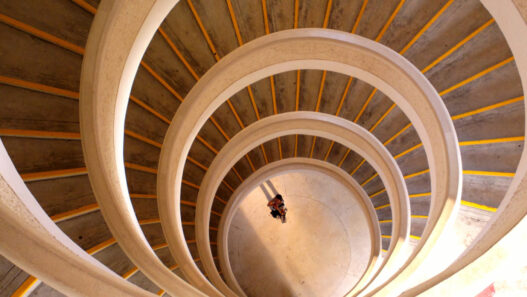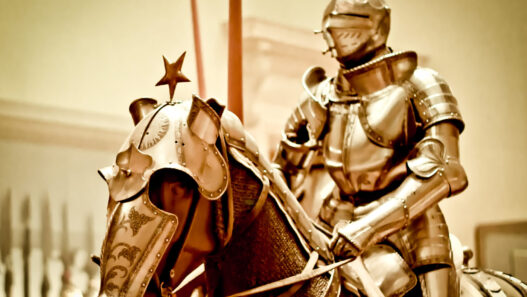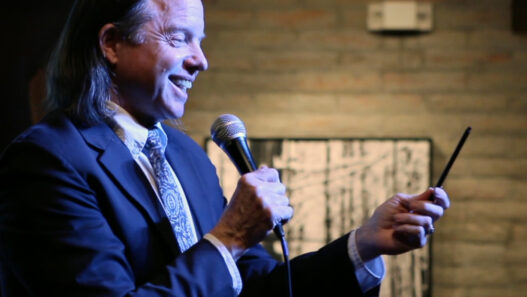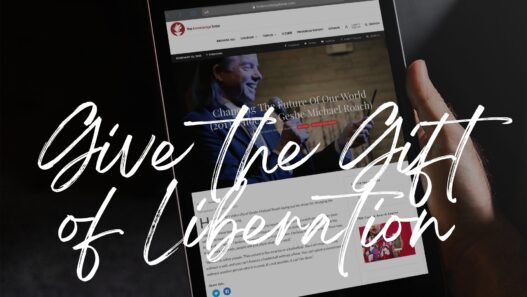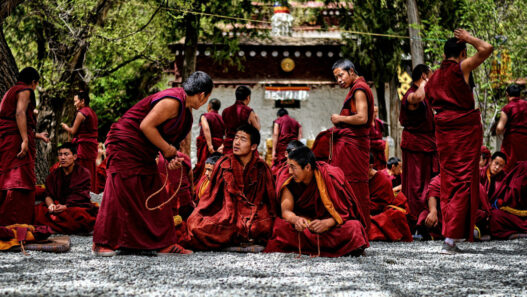Latest Posts
Purbuchok Jampa Tsultrim Gyatso (1825-1901)
The First Purchok, Ngawang Jampa (phur lcog 01 ngag dbang byams pa) was born in Chamdo (chab mdo), Kham in 1682, the water-dog year of eleventh sexagenary cycle. His father was called Anu Pakpa (a nu 'phags pa) and his mother was named Tashi Tso (bkra shis 'tsho). Ngawang Jampa was called Demchok Sung (bde mchog srung) during his childhood. He learned reading and writing, and also memorization of prayer texts at the age of seven.
He was given his pre-novice and novice vows at the age of thirteen by the Fifth Pakpa Lha, Pakpa Gyelwa Gyatso ('phags pa rgyal ba rgya mtsho, 1644-1713), who gave him the name Ngawang Jampa and later granted empowerments on Yamāntaka etc. He was trained and given his primary education in the Namdol College of Chamdo Jampa Ling Monastery (chab mdo rnam dol grwa tshang) under the guidance of the Fifth Pakpa Lha. In addition to the general course of studies, he also learned various rituals, religious dance and music (gar 'cham dbyangs rol) in the Jampa Ling tradition.
At the age of fifteen he travelled to Lhasa for further studies and matriculated in the Sera Je College of Sera Monastic University near Lhasa. He began his study with the texts on logics and other dialectical topics under the tutorship of Lama Ngawang Gyatso (bla ma ngag dbang rgya mtsho), and then the four major texts on the course of Kazhipa (dka' bzhi pa) curriculum: Abhisamayālaṃkāra, Madhyamaka, Vinaya, and Abhidharmakośa, and received the title of Geshe Kazhipa. (Kazhipa is a title or degree awarded to those who have completed their studies in only the above four major subjects and fulfilled the requirements of an examination on the subjects.)
At the age of twenty-three Ngawang Jampa visited Tashilhunpo, the seat of the Paṇchen Lamas, and received full ordination and teachings from the Fifth Paṇchen Lama, Lobzang Yeshe (paN chen bla ma 05 blo bzang ye shes, 1663-1737). He then studied with Drubkhang Gelek Gyatso (sgrub khang dge legs rgya mtsho, 1641-1713) who later became is principal tutor and received detailed teachings on Lamrim, Lojong Dondunma (blo sbyong don bdun ma), Guru Yoga (bla ma'i rnal 'byor), the Three Principle Paths (lam gtso rnam gsum), and Ganden Mahāmudrā (dga' ldan phyag chen) and many more. Gelek Gyatso also initiated Ngawang Jampa into the practice of Pelden Lhamo (dpal ldan lha mo) and also granted empowerment and esoteric instructions on Yamāntaka tantra. The Forty-ninth Ganden Tripa Lobzang Dargye (dga' ldan khri pa 49 blo bzang dar rgyas d.u; tenure: 1708-1715) also granted him empowerments on many tantric deities including Vajramala and Yamāntaka. Ngawang Jampa studied with numerous other lamas, including Drubkhang Zhogpa Donyo Khedrub (grub khang zhogs pa don yod mkhas grub, 1671-1737), Jampel Dewai Dorje ('jam dpal bde ba'i rdo rje, d.u.), Lama Sonam Zangpo (bla ma bsod nams bzang po, d.u.) and Ngawang Chokden ngag dbang mchog ldan, d.u.), the abbot of Lower Tantric College with whom he exchanged many teachings.
In the first years of the eighteenth century Ngawang Jampa settled in a cave on a small ridge called Purchok Ri (phur lcog ri), or "Kila Pinnacle Mountain," that his teacher Gelek Gyatso had developed purportedly based on a dream he had in which Tonnyon Samdrub, (thod smyon bsam grub, d.u.), a grandson of Machik Labdron (ma cig lab sgron, 1055-1149), instructed him to build a house there. With Gelek Gyatso preparing to enter retreat on the site, buildings were quickly set up around the cave, and a hermitage thus established, named Purchok (phur bu chog) or Purchok (phur bu lcog). Monks came from Gelek Gyatso's own hermitage, Sera Utse (se ra dbu rtse) for teachings on bodhicitta and the consecration ceremony.
Gelek Gyatso continued to oversee subsequent development of the site, and Ngawang Jampa, despite being by then an accomplished scholar, worked with the other monks in construction work. The Paṇchen Lama later composed the constitution (bca' yig) for the hermitage, and Gelek Gyatso, announcing that the site was in fact the palace of Cakrasaṃvara, advised Ngawang Jampa to institute the practices of that deity. Gelek Gyatso also initiated Ngawang Jampa in the practice of the Six-Arm Mahākāla short before his nirvana.
Over the next five decades Ngawang Jampa worked to develop the hermitage that gave him the name under which he is best known - Purchok or Purbuchok. In 1733, with the patronage of Polhane Sonam Topgye (pho lha nas bsod nams stobs rgyas, 1689-1747) who ruled Tibet for twenty years in the middle of the eighteenth century, he built a large courtyard and assembly hall. Later patrons of the hermitage and Ngawang Jampa included the Seventh Dalai Lama, Kelzang Gyatso (ta la'i bla ma 07 skal bzang rgya mtsho, 1708-1757) and a prominent Lhasa family named Padrong Shakpa (dpa' grong shag pa), which sponsored a renovation in 1735 and an expansion of the assembly hall in 1742.
When not in residence at Purbuchok, Ngawang Jampa travelled widely and visited many monasteries in Kham and U-Tsang including Chamdo Jampa Ling (chab mdo byams pa gling), Tashilhunpo in Tsang, Nartang (snar thang), Lhaden Gyukhang (lha ldan rgyud khang), Nyetang (snye thang) and many others.
Ngawang Jampa first taught in 1714; in 1717 he gave a detail commentarial teaching on Lamrim for about a month from the eighth of the third month to the seventh of the fourth month of the Tibetan year, a schedule he followed in subsequent years. Following the Lamrim teachings he would give the boddhicitta offering-prayer on eight of the fourth month, open teachings for three days from the ninth to the twelfth, either initiation or empowerment on Avalokiteśvara on the thirteenth, Fasting on the fourteenth and fifteenth, and then from eighteenth or nineteenth, restricted teaching on Yamāntaka, Cakrasaṃvara, Guhyasamāja. For the Autumn session, he gave teachings on other versions of Lamrim for about two weeks from the eighteenth to the new moon day of the eighth Tibetan Month. Thus this schedule became regular for every year until he reached to the age of eighty except during his visit to Chamdo, Reting, and Tsang that accounted a few years.
Jetsun Ngawang Jampa was always closely in touch with the Fifth Paṇchen Lama and the Seventh Dalai Lama whom he visited frequently and made maṇḍala offerings, and they often ate together. The Dalai Lama also discussed many crucial points of philosophy as well as practice on sutra and tantra with Purchok. The Dalai Lama also provided an annual supply of tsampa.
He is counted as the fifty-third lineage holder of the Lamrim line and the seventeenth in the line of lamas of the close lineage of Mahāmudrā that Tsongkhapa Lobzang Drakpa (rje tsong kha pa blo bzang grags pa 1357-1419) is said to have received from Mañjuśrī.
He sponsored a richly built temple in Sera Monastery and also few times printing of the complete set of Kangyur edition. He also made abundant offerings annually during the annual prayer-festival, and also to the monasteries including the four main seats of Geluk learning.
Ngawang Jampa transmitted Lamrim to numerous disciples such as Longdol Lama Ngawang Lobzang (klong rdol bla ma ngag dbang blo bzang, 1719-1794). Among other important disciples were the Eighth Dalai Lama, Gyelwa Jampel Gyatso (rgyal ba 'jam dpal rya tsho, 1758–c.1804); the Sixth Paṇchen Lama, Lobzang Pelden Yeshe (paN chen bla ma 03 blo bzang dpal ldan ye shes, 1738-1780); the Seventh Demo Rinpoche, Ngawang Jampel Delek Gyatso, who was the first Regent of Tibet (rgyal tshab de mo rin po che sku khreng 07, ngag dbang 'jam dpal bde legs rgya mtsho, d.1777); the Sixth Pakpa Lha, Jigme Tenpai Gyatso ('phags pa lha 06 'phags pa 'jigs med bstan pa'i rgya mtsho, 1714-1754); the Fourth Zhiwa Lha, Pakpa Gelek Gyeltsen (zhi ba lha 04 'phags pa dge legs rgyal mtshan, 1720-1799); the Sixth Chakra, Ngawang Trinle Pelzang (lcags ra 06 ngag dbang 'phrin las dpal bzang, 1730-1794); Tsechoklingpa Yongdzin Yeshe Gyeltsen (tshe mchog gling pa yongs 'dzin ye shes rgyal mtshan, 1713-1793); the Second Jamyang Zheba, Konchok Jigme Wangpo ('jam dbyangs bzhad pa 02 dkon mchog 'jigs med dbang po, 1728-1791); the Third Tubkwan, Lobzang Chokyi Nyima (thu'u bkwan 03 blo bzang chos kyi nyi ma, 1737-1802); the Third Changkya, Rolpai Dorje (lcang skya 03 rol pa'i rdo rje, 1717-1786); the Second Kondor Tulku, Lobzang Wangchuk (dkon rdor sprul sku 02 blo bzang dbang phyug, 1789-1758); the Sixty-seventh Ganden Tripa, Jamyang Monlam (dga' ldan khri 62 'jam dbyang smon lam, 1729-1798); and Arik Geshe Jampa Ozer (a rig dge bshes byams pa 'od zer, 1728-1803).
The works of Purchok Ngawang Jampa were collected into three volumes containing fifty two texts covering subjects such as answers and clarifications on certain objections on the crucial points of philosophy, Lamrim, Lojong, commentaries on certain important topics of sutra, sadhanas, rituals of maṇḍala, yagsha, and generation and completion stage practice (bskyed rdzogs) of Guhyasamāja tantra, catalogues of holy objects, histories, and biographies. Several of his texts remain standard works in the Geluk geshe curricula.
Purchok Ngawang Jampa passed into nirvana in 1762, at the age of eighty-one.




